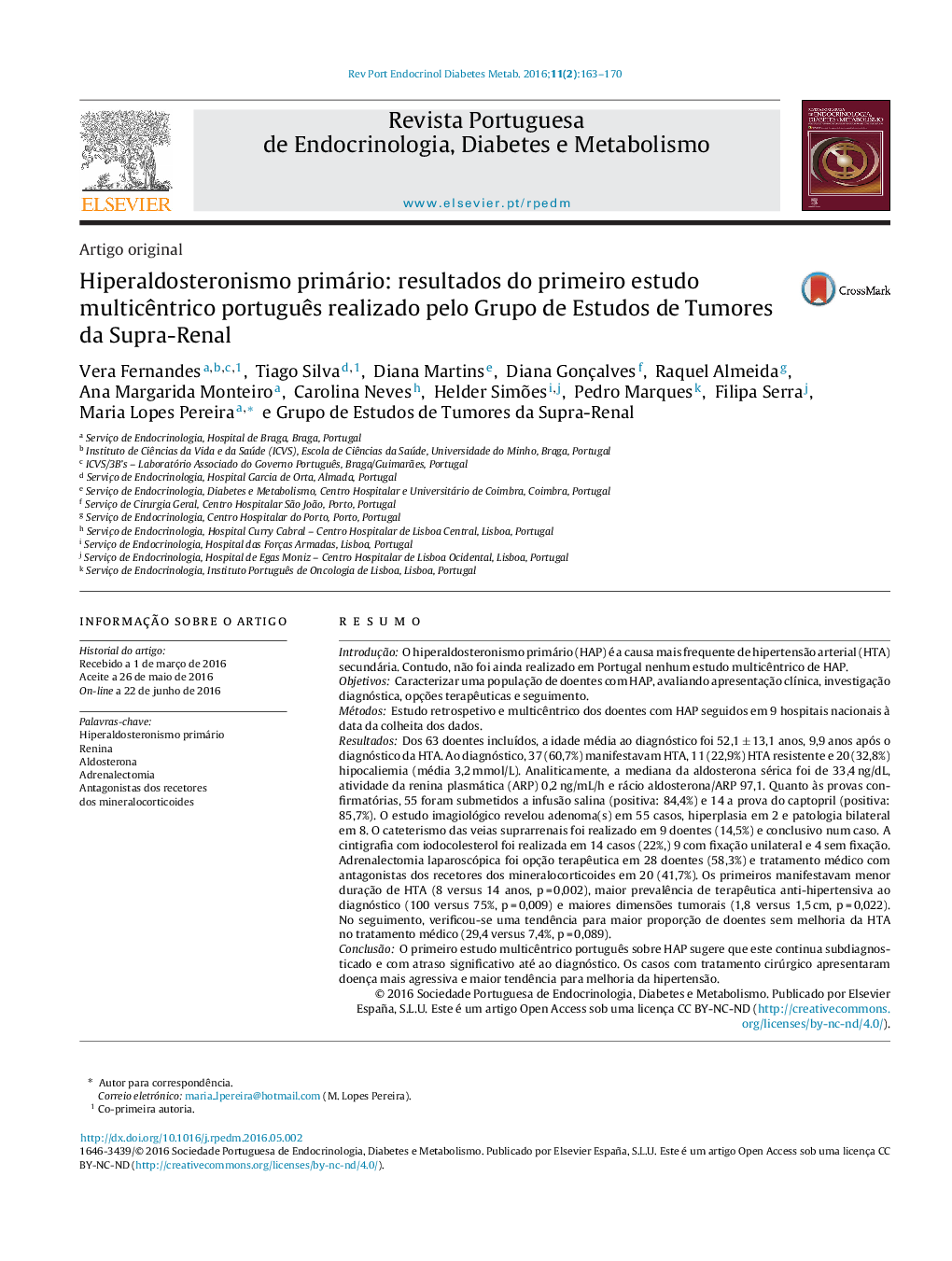| Article ID | Journal | Published Year | Pages | File Type |
|---|---|---|---|---|
| 3278192 | Revista Portuguesa de Endocrinologia, Diabetes e Metabolismo | 2016 | 8 Pages |
ResumoIntroduçãoO hiperaldosteronismo primário (HAP) é a causa mais frequente de hipertensão arterial (HTA) secundária. Contudo, não foi ainda realizado em Portugal nenhum estudo multicêntrico de HAP.ObjetivosCaracterizar uma população de doentes com HAP, avaliando apresentação clínica, investigação diagnóstica, opções terapêuticas e seguimento.MétodosEstudo retrospetivo e multicêntrico dos doentes com HAP seguidos em 9 hospitais nacionais à data da colheita dos dados.ResultadosDos 63 doentes incluídos, a idade média ao diagnóstico foi 52,1 ± 13,1 anos, 9,9 anos após o diagnóstico da HTA. Ao diagnóstico, 37 (60,7%) manifestavam HTA, 11 (22,9%) HTA resistente e 20 (32,8%) hipocaliemia (média 3,2 mmol/L). Analiticamente, a mediana da aldosterona sérica foi de 33,4 ng/dL, atividade da renina plasmática (ARP) 0,2 ng/mL/h e rácio aldosterona/ARP 97,1. Quanto às provas confirmatórias, 55 foram submetidos a infusão salina (positiva: 84,4%) e 14 a prova do captopril (positiva: 85,7%). O estudo imagiológico revelou adenoma(s) em 55 casos, hiperplasia em 2 e patologia bilateral em 8. O cateterismo das veias suprarrenais foi realizado em 9 doentes (14,5%) e conclusivo num caso. A cintigrafia com iodocolesterol foi realizada em 14 casos (22%,) 9 com fixação unilateral e 4 sem fixação. Adrenalectomia laparoscópica foi opção terapêutica em 28 doentes (58,3%) e tratamento médico com antagonistas dos recetores dos mineralocorticoides em 20 (41,7%). Os primeiros manifestavam menor duração de HTA (8 versus 14 anos, p = 0,002), maior prevalência de terapêutica anti‐hipertensiva ao diagnóstico (100 versus 75%, p = 0,009) e maiores dimensões tumorais (1,8 versus 1,5 cm, p = 0,022). No seguimento, verificou‐se uma tendência para maior proporção de doentes sem melhoria da HTA no tratamento médico (29,4 versus 7,4%, p = 0,089).ConclusãoO primeiro estudo multicêntrico português sobre HAP sugere que este continua subdiagnosticado e com atraso significativo até ao diagnóstico. Os casos com tratamento cirúrgico apresentaram doença mais agressiva e maior tendência para melhoria da hipertensão.
IntroductionPrimary Aldosteronism (PA) is the most prevalent cause of secondary hypertension. Nevertheless, there is no portuguese multicenter study characterizing PA patients.AimsTo characterize the clinical presentation, diagnostic workup, treatment and follow‐up of patients with confirmed PA.MethodsRetrospective multicenter study of PA patients followed in 9 portuguese hospitals.ResultsSixty‐three cases were selected with a mean age of diagnosis of 52.1 ± 13.1 years, 9.9 years after the diagnosis of hypertension. At presentation, 37 cases (60.7%) had hypertension, 11 (22.9%) had resistant hypertension and 20 (32.8%) of patients had hipokalemia (mean 3.2 mmol/L). Baseline laboratory showed a mean serum aldosterone of 33.4ng/dL, plasmatic renin activity (PRA) of 0.2ng/mL/h with an aldosterone/PRA ratio of 97.1. Confirmatory testing was performed with saline infusion in 55 patients (positive in 84.4%) and captopril test in 14 (positive in 85.7%). Imaging showed adenomas in 55 cases, hyperplasia in 2 and bilateral cases in 8. Arterial venous sampling (AVS) was performed in 9 patients (14,5%) and was conclusive in 1. Iodocholesterol scintigraphy was done in 14 cases (22%) with unilateral fixation in 9 and no fixation in 4. Patients were treated with laparoscopic adrenalectomy in 28 cases (58.3%) and mineralocorticoid receptor antagonists in 20 cases (41.7%). The surgical treated group had less duration of hypertension (8 versus 14 years, p = 0.002), higher prevalence of anti‐hypertensive drugs at presentation (100 versus 75% p = 0.009) and bigger tumour size (1.8 versus 1.5 cm, p = 0.022). During follow‐up there was a trend towards a greater proportion of patients with no hypertension improvement in the medical treatment group (29.4% versus 7.4%, p = 0.089).ConclusionThis is the first Portuguese PA multicenter study. It suggests that PA remains an under‐diagnosed condition with a significant delay in diagnosis. Surgical treated patients had a more aggressive disease and showed a trend towards better hypertension control.
